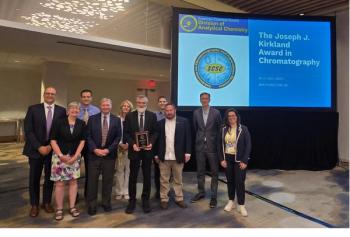
- February 2023
- Volume 19
- Issue 02
- Pages: 2–8
Improving Chromatographic Results for Oligonucleotides with Column Hardware
This article discusses the main influences in oligonucleotide analysis using ion-pair (IP) reversed-phase chromatography.
The COVID-19 pandemic made it very obvious: oligonucleotide-based drugs are gaining in importance in the treatment of a number of diseases. As a result, research and development and quality control laboratories require robust and sensitive analytical methods. Ion pair (IP) reversed‑phase chromatography is seen as the gold standard for oligonucleotide analysis. This article discusses the main influences in oligonucleotide analysis using IP reversed-phase chromatography. In addition to suitable mobile and stationary phases, the column hardware also has an impact on the column performance. This can be eliminated by the use of bioinert ultrahigh‑pressure liquid chromatography (UHPLC) columns.
Oligonucleotides have grown in importance in medical approaches and they are already used to treat several diseases. In the context of the COVID-19 pandemic, messenger ribonucleic acid (mRNA)-based vaccines have experienced a massive boost. Other oligonucleotide medications are based on small interfering RNA (siRNA) or antisense oligonucleotides (ASOs) and target different diseases (1,2). To date, 17 different oligonucleotide-based pharmaceuticals are registered in the US and in the EU (3).
Robust and highly sensitive analytical methods are therefore required. Ion pair (IP) reversed-phase liquid chromatography (LC) remains the gold standard for the characterization of oligonucleotides and their by-products, while other modes, such as anion-exchange chromatography (AEC) or hydrophilic interaction liquid chromatography (HILIC), are alternative approaches (4,5).
In order to achieve optimum results, several influences have to be considered. Not only is the selection of the ion‑pairing reagent and the organic modifier essential but also their concentration and the corresponding eluent’s pH value. The column temperature as well as the applied gradient have a strong influence on the separation as well. Furthermore, the optimum stationary phase with regard to modification, pore size, and column hardware plays another major role.
The Mobile Phase
Triethylamine (TEA) is usually used in combination with 1,1,1,3,3,3-hexafluoro-2-propanol (HFIP) and methanol as organic modifier. This buffer system provides high resolution and high sensitivity in electrospray ionization-mass spectrometry (ESI-MS).
Mixtures of four phosphodiester RNAs (14–21 mer, PO RNA) as well as two phosphorothioate RNAs (20–21 mer, PS RNA) were tested as part of a systematic evaluation of the mobile phase (6). The general method conditions were kept constant as follows: flow rate 0.42 mL/min, UV detection at 260 nm, and injection volume 1 µL. The general gradient was 1% B/min (starting from 8% B) and general temperature was 65 °C, unless stated otherwise. A 50 × 2.1 mm, 1.9‑µm bioinert widepore column was used.
Initially, the influence of different alkyl amines as ion-pairing reagents with the addition of HFIP of different concentrations was determined. Comparing TEA, n-butylamine (BA), dibutylamine (DBA), and hexylamine (HA) showed that TEA provided consistently good results. In some cases, better resolution was obtained using other alkylamines. A concentration of 15 mM DBA or HA in combination with 400 mM HFIP gave higher resolutions for the PO RNAs, while for PS RNAs, lower amine concentrations of 2 mM seemed to be better suited. The ideal combination was ultimately dependent on the oligonucleotides’ nature and is not predictable.
In further tests, the concentration of TEA (1–30 mM) and therefore the corresponding pH (7.4–8.9) were varied (not shown). The HFIP concentration was set to 100 mM. An increase in retention could be seen up to a concentration of 8 mM (pH 8.3). Above that the retention was reduced again, resulting in a decrease in resolution. The best results were obtained at a pH around 8, and further evaluations were performed. The concentration of HFIP was varied to adjust the pH between 7.8 and 8.3. High concentrations of both components (15 mM TEA and 400 mM HFIP) led to the best resolutions (Figure 1). In contrast to the applied UV detection, lower concentrations may be better suited for use with MS detection.
Temperature optimization in a range of 25–90 °C resulted in increased resolution. Even at 25 °C sufficient resolution was achieved for PO RNA. For PS RNA, a minimum temperature of 45 °C was required, while the best result was obtained at 65 °C (Figure 2). As the stability of the oligonucleotides need to be considered as well, the application of higher temperatures may not be possible.
Variation of the gradient slope between 0.4% and 2.0% methanol/min provided the required resolution in all cases. Shallower gradients resulted in a higher resolution, while steeper ones allowed faster analysis with higher sensitivities.
In conclusion, for both PO RNA and PS RNA, a good retention and resolution was obtained using TEA-HFIP at a high concentration and a pH of about 8. However, the type and concentration of the optimum ion‑pair reagent is dependent on the oligonucleotides being analyzed. A column temperature of 60 °C is the ideal starting point. The gradient slope has a less pronounced influence but can be used for further optimization.
The Stationary Phase
The analysis of oligonucleotides can be quite demanding on the stationary phase. According to the requirements of the mobile phase as described above, the phase needs to be very robust and withstand high pH values and temperatures. Modern stationary phases based on hybrid silica particles fulfil the criteria: they are stable at pH 1–12 and temperatures up to 90 °C. Their chemical and mechanical stability comes from the base particle material, organic‑inorganic hybrid silica, in combination with a trifunctional bonding as well as multiple endcapping.
C18-modified stationary phases are the preferred choice for the separation of oligonucleotides—though C8 or phenyl modification also provide a suitable selectivity for selected substances. In addition to the modification, the pore size is also an important parameter. In order to evaluate its influence, three C18 phases with different pores sizes were tested: 8 nm, 12 nm, and 30 nm.
The widepore phase (30 nm) provided the shortest retention time for the separation of the 14–21 mer PO RNAs (not shown), and the best resolution was obtained between the 20 and 21 mer. The 12 nm phase offered better resolution for the shorter oligonucleotides, while the smallest pore showed neither an advantage for the resolution nor for the retention.
Figure 3 shows the separation of DNA‑fragments of different lengths (10–120 mer) with the three different C18 stationary phases. Larger oligonucleotides were able to penetrate the 30 nm pore and achieve an ideal interaction with the stationary phase. In addition, shorter retention times with sharper peaks were achieved. The C18 phase with the 12 nm pore size demonstrated some advantages for the shorter oligonucleotides (up to 30 mer). A smaller pore size of 8 nm was not suitable for the analysis of oligonucleotides. Therefore, a robust widepore stationary phase with 30 nm
pore size is the best choice.
The Column Hardware
The conventionally used materials for tubing and column hardware pose a special challenge for the analysis of oligonucleotides. Even though stainless steel provides mechanical resilience and compatibility with most solvents, eluents such as methanol or acetonitrile can cause corrosion. These solvents also cause metal erosion, even from titanium hardware, and result in correspondingly low MS performances (7). The resulting positively charged surface can lead to undesired ionic interactions with the analytes (8). As a consequence of the interactions with their electron-rich backbone, the oligonucleotides can be irreversibly adsorbed. This nonspecific adsorption has a negative influence on recovery and peak shape. This effect is even more critical when working at low to neutral pH, as metals are more electropositive at these conditions (9).
To overcome this problem, ultrahigh‑pressure liquid chromatography (UHPLC) systems and columns can be passivated with strong acids or preconditioned with a similar sample. However, this procedure is time-consuming and needs to be repeated. Ion suppression in detection by ESI-MS can also be a negative consequence (10). Furthermore, a change of sample can lead to nonspecific adsorption once more (5).
The column body represents more than 70% of the surface that the analytes are in contact with (10). Consequently, a bioinert column body and frits can offer an improvement in performance. Different bioinert concepts are available: a bioinert coating of the stainless steel column body and frits, PEEK-lined stainless steel columns in combination with PEEK frits, and columns made of titanium. A bioinert coating and a PEEK-lining are preferable to titanium because, with the latter, metal erosion can still occur, resulting in a contamination of the silica bed. The eluted titanium is able to cause an ionic bonding, with free remaining silanol groups causing adsorption of the analytes onto the stationary phase. This effect is particularly pronounced for stationary phases without or with insufficient endcapping (11).
Figure 4 shows the separation of the two PS RNAs on a standard stainless steel column and on a bioinert coated column. The bioinert column provided double the peak height and peak area of the standard column. The analytical sensitivity was significantly enhanced, helping to save precious samples without any loss due to the higher recovery. Using a bioinert coated column also negated the need for sample preconditioning.
As the UHPLC system configuration also affects the sensitivity, a bioinert/metal-free high performance liquid chromatography (HPLC) system should be used. Even though the column offers the largest surface area in the flow path, oligonucleotides can interact with metal components beyond the column as well.
Conclusion
In order to achieve optimum results in oligonucleotide analysis, the most suitable mobile phase, stationary phase, and column hardware must be selected. Good resolution and retention times were obtained when the ion-pairing effect was enhanced, therefore applying high TEA concentrations at a pH of about 8 should be used. The temperature is another key factor. Temperatures near 60 °C are the first choice. However, the ideal temperature varies depending on the target nucleotide samples. A gradient slope of 2.0–0.4% methanol/min works in most cases, and should be optimized in regard to resolution and peak height (sensitivity).
A stationary phase with a C18 modification and a widepore of 30 nm is a good choice based on the applicable molecular weight range and chemical stability. For smaller oligonucleotides, a standard pore size of 12 nm also works well. If the ideal separation is not obtained with these column types, a phase screening is generally recommended.
Bioinert column hardware is preferable over standard stainless steel columns for oligonucleotide analysis. By using these, not only is the time for passivation or conditioning saved but also the adsorption of oligonucleotides is suppressed long-term.
References
- Bateman-House, A.; Kearns, L. Individualized Therapeutics Development for Rare Diseases: The Current Ethical Landscape and Policy Responses. Nucleic Acid Ther. 2021, 32 (2), 11–117. DOI: 10.1089/nat.2021.0035
- Goyon, A.; Yehl, P.; Zhang, K. Characterization of Therapeutic Oligonucleotides by Liquid Chromatography. J. Pharm. Biomed. Anal. 2020, 182, 113105. DOI: 10. 1016/j.jpba.2020.113105
- Talap, J.; Zhao, J.; Shen, M.; et al. Recent Advances in Therapeutic Nucleic Acids and their Analytical Methods.J. Pharm. Biomed. Anal. 2021, 206, 114368. DOI: 10.1016/j.jpba.2021.114368
- Gilar, M.; Fountain, K.J.; Budman, Y.; et al. Ion‑Pair Reversed-Phase High-Performance Liquid Chromatography Analysis of Oligonucleotides. J. Chromatogr. A 2002, 958, 167–182. DOI: 10.1016/S0 021-9673(02)0 0306-0
- Lardeux, H.; Goyon, A.; Zhang, K.; et al. The Impact of Low Adsorption Surfaces for the Analysis of DNA and RNA Oligonucleotides. J. Chromatogr. A 2022, 1677, 463324. DOI: 10.1016/j.chroma.2022.463324
- Eßer, D.; Tsutsui, K.; Matsumura, C.; Shoji, N.; Kanezaki, H. “Analytical Study of the Separation Behaviour of Oligonucleotides on IP-RPLC,” poster presented at the 33rd International Symposium on Chromatography Conference, Budapest, Hungary, 2022.
- Mowery, R. A. The Corrosion of 316 Stainless Steel in Process Liquid Chromatography with Acetonitrile or Methanol Carriers. J. Chromatogr. Sci. 1985, 23, 22–29 DOI: 10.1093/chromsci/23.1.22
- Stoll, D. R.; Hsiao, J. J.; Staples, G. O. Troubleshooting LC Separations of Biomolecules, Part 1: Background, and the Meaning of Inertness, LCGC Europe 2020, 33 (3), 122–126.
- Guimaraes, G. J.; Bartlett, M. G. The Critical Role of Mobile Phase pH in the Performance of Oligonucleotide Ion-Pair Liquid Chromatography–Mass Spectrometry Methods. Futur. Sci. OA. 2021, 7 (10). DOI: 10.2144/fsoa- 2021- 0084
- Gilar, M.; DeLano, M.; Gritti, F. Mitigation of Analyte Loss on Metal Surfaces in Liquid Chromatography. J. Chromatogr. A 2021, 1650, 462247. DOI: 10.1016/ j.chroma.2021.462247
- De Pra, M.; Greco, G.; Krajewski, M. P.; et al. Effects of Titanium Contamination Caused by Iron-Free High Performance Liquid Chromatography Systems on Peak Shape and Retention of Drugs with Chelating Properties. J. Chromatogr. A 2020, 1611, 460619. DOI: 10.1016/j.chroma.2019.460619
Daniel Eßer studied chemistry at the University of Applied Sciences Bonn‑Rhein-Sieg, in Rheinbach, Germany, with a focus on pharmaceutical and analytical chemistry. He received his Ph.D. in pharmaceutical and medicinal chemistry at the University of Düsseldorf, Germany. During his postdoc at the Institute of Pharmaceutical and Medicinal Chemistry of the University of Düsseldorf, he established a nanoLC–MS system. In 2013 he joined YMC Europe in Dinslaken, Germany, as product specialist analytical chromatography. Since 2017, he has been responsible for YMC’s analytical (U)HPLC column portfolio as product manager analytical chromatography.
Ann Marie Rojahn studied chemistry and biotechnology in combination with an apprenticeship as chemical laboratory assistant at the University of Applied Sciences in Krefeld, Germany. After receiving a bachelor’s degree, she pursued a master’s programme in chemistry at the University of Düsseldorf, Germany, with a focus on organic chemistry. Since 2019, she has worked for YMC Europe in Dinslaken as product specialist analytical chromatography.
Articles in this issue
almost 3 years ago
Vol 19 No 2 The Column February 2023 Europe & Asia PDFalmost 3 years ago
Vol 19 No 2 The Column February 2023 North American PDFalmost 3 years ago
The Chromatographic Society 2023 Martin and Jubilee Awardsalmost 3 years ago
Astrea Bioseparations Acquires Delta Precision Ltd.almost 3 years ago
HPLC 2023 Grant Supportalmost 3 years ago
Bruker and Biognosys Announce Partnershipalmost 3 years ago
HPLC 2023 Event Previewalmost 3 years ago
Rising Stars of Separation Science: Varoon SinghNewsletter
Join the global community of analytical scientists who trust LCGC for insights on the latest techniques, trends, and expert solutions in chromatography.





